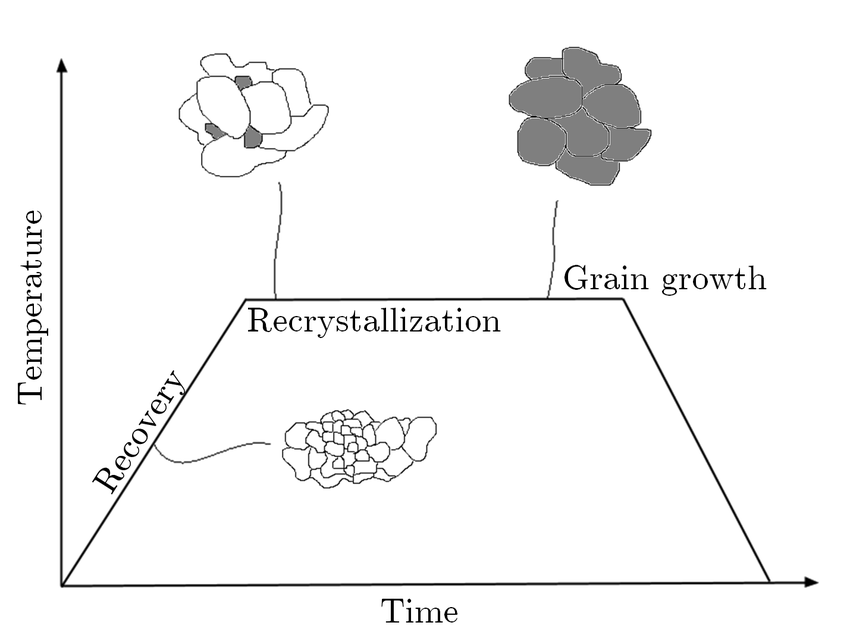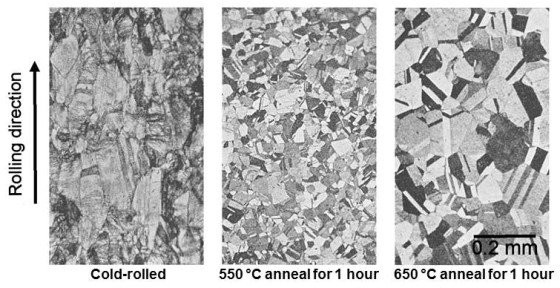What is Annealing ?
Heat treatment process for Annealing
|
| Annealing is one of the process of heat treatment that alters the microstructure of the material to change it’s mechanical or it’s electrical properties. The reason for this process is to increase it’s ductility and can reduce the hardness to make it easier to work with. |
 |
What is Annealing? Why is it an important process?
The process where we need to do heat treatment of metal will go through different types of heat treatment depending on the stage.
The annealing process needs the material above its recrystallization temperature for a certain timeframe before cooling.
The way how annealing works is when the metal is heated to its the ideal temperature and then maintain at that temperature for a certain amount of time.
.png)
An easier example for the process of annealing is that it’s the same process of baking a pie. Once you’ve started to cook the pie in the oven, at the end of the cooking, you will let it rest for a while instead of taking it out when the timer ends.
When you made it stay in the oven for a while means this is the process of “annealing”. It’s a similar situation when doing it for metal components. |
 |
Annealing furnace, How does it work?
The annealing furnace can be considered as an oven. We’re going to do the same thing as baking the pie, but slightly different.
The way it works is by heating the metal material above its recrystallization temperature and then set for cooling after it’s been held at a specific temperature for a certain time
What’s going to happen is that, after that process, the metal will recrystallize when it’s cooled. That is when the metal material is softer and the hardness is reduced. The reason for this as they have to undergo 3 stages which are “recovery, recrystallization and the grain growth stage"
There are 3 distinct annealing stages:
1. Recovery Stage

The first step of annealing is in the recovery stage. This is where the metal is heated. The way this works is when the metal is heated using equipment such as induction furnace, oven, gas and electric furnaces. The reason for this is so that the metal is heated to a temperature where its internal structures relax.
2. Recrystallization Stage

During the recrystallization stage, the metal is heated above its recrystallization temperature so that it can reach it’s desired temperature. This process where is above the recrystallization temperature but not reaching it’s melting temperature. When the metal is being heated at its optimal temperature, new grains will develop within the metal’s internal structure without the formation of preexisting stresses.
3. Grain Growth

This is the final stage for the annealing process in heat treatment. The grains that have been developing in stage 2 are going to be fully developed. Making them more workable after the cooling process. At this stage, the metal will be on a resting stage where the cooling process begins. By maintaining it at a specific temperature, the grain will become more ductile and soft material. Makes everything easy to work with. |
 |
| You might be thinking, why does annealing even need? Why does it require in this heat treatment process? |
 |
Why is Annealing Important?
.jpg)
The reason why annealing is required is that if the metal that you’re working on is already hardened. It’s going to be hard to do work such as bending, cold forming and drawing.
By having the metal soft and more ductile, it’s easier to work with but if the metal was too hard, the metal can crack and hard to work with. By heating the metal above the recrystallization temperature, it made the metal more ductile and it can be workable again.
The annealing process can also remove stresses that can occur when wels began to solidify. It’s different for steel and alloy steel annealing, they are also can be shaped when applying heat above the recrystallization temperature.
Other metals like aluminium, brass and copper can benefit from this process. One example from this is, metal fabricators often use annealing to create complex parts and keeping the material workable by returning them close to their pre-worked state. This process is important so that we can maintain their ductility and reducing the hardness after cold working.
Annealing Workable with Alloys?
Yes. Annealing is still workable with alloys. Either partially or fully anneal that is best for non-heat-treatable alloys. The exception to this is with the 5000 series alloys, which can allow low-temperature stabilisation treatments.
The alloys are then annealed at 300 – 410°C, depending on the alloy. The time for these alloys to be heated is around 1 – 3 hours and that also depends on the workpiece and they type of the alloy. When the alloy is going to the 3rd stage which is the cooling stage, the alloys need to be cooled at a max level of 20°C per hour until the temperature reduced to 290°C.
PROS
- Improve the material to be more workable
- Increase the toughness
- Reducing the hardness of the material
- Increase the ductility and machinability
- Reduce the brittleness of metals
- Enhance their magnetic properties and electrical conductivity
DISADVANTAGES
- Time-consuming procedure (depends on which type of metal)
- Material with high temperature will take time to cool (especially when cool naturally)
So, When will you need to use Annealing?
The common applications are listed below:
- Work-hardened materials undergone a stamping process or cold drew bar stock.
- The metal wire that been drawn for one size to a much smaller size can undergo an annealing process.
- Machining operations that create high amounts of heat or metal displacement.
- Welded components are able to create residual stresses in the area exposed to elevated temperatures and to recreate uniform physical properties.
|
| |
WINTHERM Industrial ovens and furnaces aims to be SEA (Indonesia, Malaysia, Thailand and Vietnam) leading industrial ovens and furnaces maker that cater the range of other industrial ovens makers from overseas.
For more information please contact Furnace Indonesia at PT WinTherm Bara Indonesia, Jl. Jembatan Tiga Raya, No. 6A, Pejagalan, Kec. Penjaringan, Jakarta Utara, DKI Jakarta – 14440, Email : [email protected] Whatsapp : +62 812 9262 1971
Our service area in Indonesia ; Jakarta, Surabaya, Bandung, Medan, Semarang, Makassar, Palembang, Batam, Balikpapan, Samarinda, Bandar lampung, Padang, Denpasar, Malang, Yogyakarta, Palangkaraya, Pontianak |
| |
|
|
|